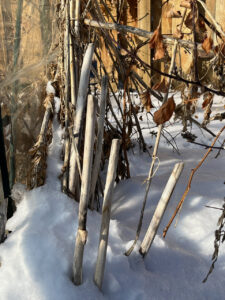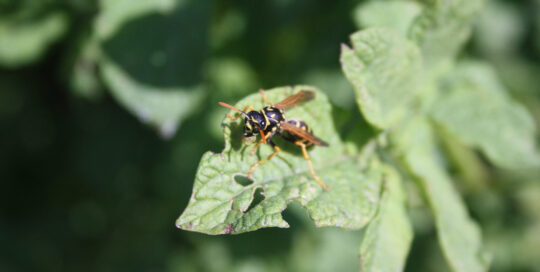Hollow Stems for Native Bees: Leave the Garden a Little Messy
Views: 144

Last week we had a warm day — without wind — and it felt like the perfect time to see how the gardens fared. With recent bouts of sub-zero weather, most everything is still very brown and dormant, but even so, it reminded me that there are reasons to not disturb the garden in the late winter. Leaving the leaf litter for beneficial insects and hanging onto hollow stems for the native bees is the way to go this time of the season.
Having a pollinator friendly garden is a benefit to everyone, including those insects that prey upon the ones that cause us problems. Besides avoiding the use of pesticides in the lawn and garden, one of the best things we can do is keep the garden a little messy. At least, don’t do a thorough cleanup until the weather is consistently in the 50s.
Leave the Leaves
We have a number of Sphynx and hawk moths in our area, and it’s always a delight to watch them buzzing, in their hummingbird-like fashion, among the flowers in the evening. Many of the species have two lifecycles per year, but the latter one involves burrowing into the garden debris or leaf litter to overwinter in the pupae stage. Local reports indicate that in some years, they emerge by April in this region, so it’s worthwhile to not dig up the garden until at least then.
Attracting Butterflies to Your Garden
Hollow Stems for Bee Nurseries
One thing I noticed while examining the garden was a bunch of sturdy, hollow stems from the lovage plants. These are absolutely perfect for overwintering insects.
What’s also interesting is not only do hollow stems offer winter habitat, they’re where native bees prefer to lay their eggs in the spring, according to the Xerces Society. They recommend trimming the seed head off of dried stems, such as with coneflowers, to open up the cavity for bees. While leaving all of the stems may not work for every landscape (especially when we’re gung-ho with the clippers in the spring), even leaving a few is helpful.
Even though it’s a good thing to put out bee houses in the spring to provide this habitat for solitary bees, such as Mason bees, a combination of the bee house and natural stems is the best way to go.
How Long to Resist
But is there a way to clean up the garden and provide habitat for overwintering pollinators and beneficial insects? Absolutely! Just leave a little.
While allowing the fall mess to remain in place is optimal for the native insects, in reality, when the weather finally warms up enough, it’s time to whip things into shape for the season. With that said, look at your lawn and garden and see if it’s possible to leave unkept edges in some areas. For me, there are spots behind the garden shed, along with underneath the large golden currant bushes that I’ll allow to remain unkept, at least until May.
With my sunflower forest, I’ll take the bulk of them down, leaving a few — with their heads snapped off— against the fence for the native bees. And when I cut back the fall-bearing raspberries, most will still have stems six to eight inches tall, which is enough for insects. I’ll even leave some of the hollow stems of the lovage plants in a couple of corners because those look like the upper end condos of the native bee world.
One aspect that will be interesting to observe is whether I notice an increase in butterflies and other beneficial insects with the addition of the wood mulch over much of the garden. There’s no turning over the soil this year, so I wonder if we’ll have more in the garden because they have more places to spend the cold months.
Meet Amy Grisak
Amy is a freelance author and photographer in Great Falls, MT who specializes in gardening, foods, and sustainable agriculture. She provides information on every kind…
Amy's Recent Posts

Looking into the Crystal Ball for a Pest Report








